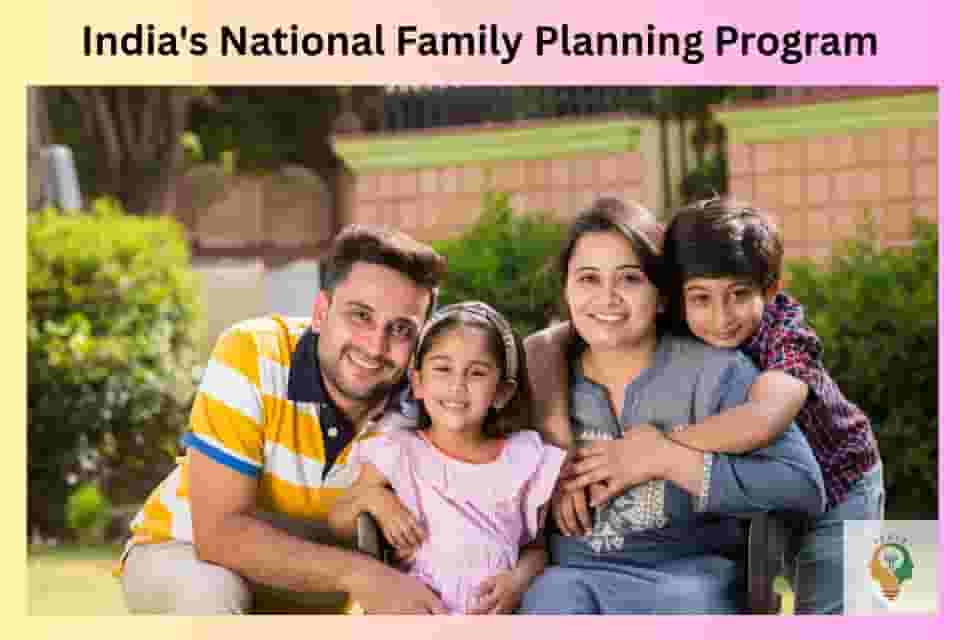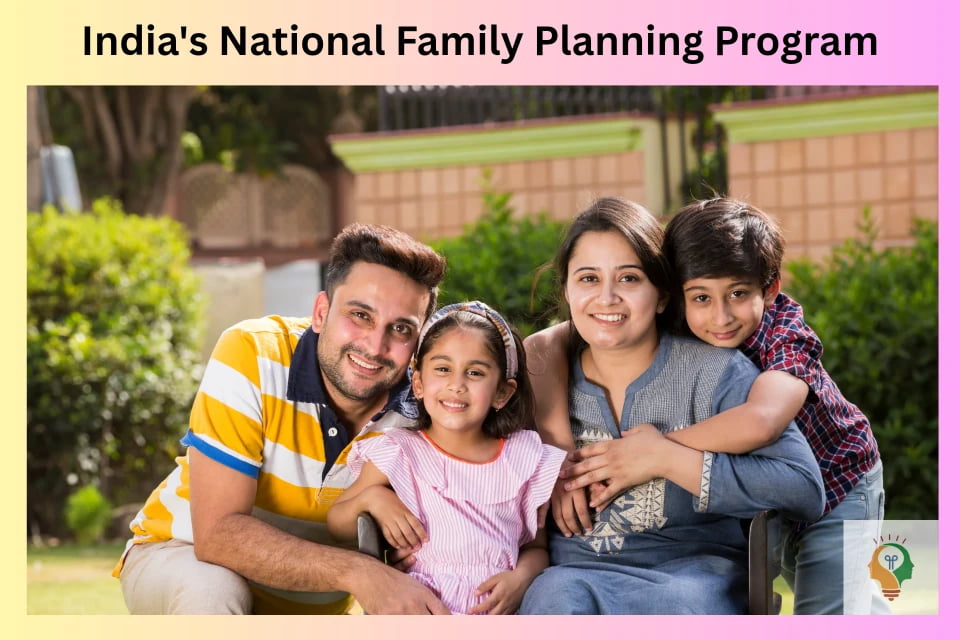India's National Family Planning Program: Simplified Overview
Updated: 08-10-2025 at 5:24 PM
1k


India’s National Family Planning Programme is primarily aimed at providing better reproductive care, regulating population size and controlling maternal mortality and morbidity and child mortality every year. It was started in the year 1952 and is the first one for the global level wherein numerous services and government schemes are provided to enhance the use of family planning facilities to build a healthy nature for families.
Overview
The table showcases the key highlights of India’s National Family Planning Programme:
| Scheme Name | India’s National Family Planning Programme |
|---|---|
| Launch Year | 1952 |
| Key Services | Free contraceptives, sterilisation, counselling, post-partum care |
| Methods | Permanent (e.g., sterilisation) and temporary (e.g., condoms, injections) |
| Special Schemes | Mission Parivar Vikas, Janani Suraksha Yojana, FPIS |
| Beneficiary Compensation | Male: ₹1,100; Female: ₹250-600; Incentives for contraceptive use |
Read More: All About The Mother And Child Card (MCP)
What Is the National Family Planning Program?
The National Family Planning Program was formulated for the first time in India in 1952. Before then, it was the world’s first such program, and its functions have expanded not only to act as a tool for managing population growth but also as tools for encouraging healthy reproductive behaviour and preventing deaths of mothers, infants, and children.
Objectives Of The Family Planning Program
The Family Planning Program aims to stabilise population growth and improve maternal and child health. It promotes responsible family planning practices to ensure a healthy and sustainable future.
The following are the objectives of the Family Planning Program;
-
Access to Services: It helps in a way so that all possible couples empowered for family planning get information, supplies or any kind of family planning services that are needed.
-
Contraceptive Use: Its agenda is to expand the use of modern methods of contraception to enhance couples’ protection of fertility.
-
Healthier Lives: An additional target is enhancing the quality of families' reproductive health, which implies a decrease in mortality and morbidity related to childbirth for both mothers and infants.
National Family Planning Program Goals
The government program focuses on reducing fertility rates and ensuring access to contraceptives. It also aims to decrease maternal and infant mortality rates by promoting reproductive health.
Below are the important goals of the National Family Programme
-
Universal Access: Make sure all people have access to sexuality and reproductive health care, including information on family planning.
-
Fertility Reduction: A total Fertility Rate (TFR) of less than 1 needs to be ensured. 7, implying a reduced rate of births or births per woman.
-
More Choices: Increase the choice of contraceptive methods, including injectable Antara and weekly contraceptive pills, Chhaya.
-
Healthy Birth Spacing: On family planning, stress for the couple to space their children by enlightening them on how to plan for the number of children they want.
-
Better Sterilisation Services: Increase the capacity of sterilisation and promote awareness of the services offered.
-
Strengthening Supply Chains: Strengthen the adequate availability of family planning commodities for instance; contraceptives in the country.
Read More: LaQshya Programme For Neonatal Care
What Services Are Available Under The Family Planning Program?
The government program offers free contraceptives, sterilisation procedures, counselling services, and pregnancy-related care. It also provides access to health education and awareness campaigns. The program offers various services, including:
-
Sterilisation Services: Some of the permanent methods such as female sterilisation and male vasectomy are offered on certain days in health facilities.
-
New Contraceptives: Previously DMP only offered oral pills but the combination of pills, injectable contraception such as Antara and weekly pills such as Chhaya are also included in the program.
-
Post-Partum Services: Women can go for PPIUCD and PAIUCD contraceptives after they have given birth.
-
Home Delivery of Contraceptives: ASHA workers provide condoms and pills under the HDC Scheme by directly providing them to each home.
-
Awareness Campaigns: It includes media such as family planning promotional campaigns, special events and public lectures.
What Are The Methods Of Family Planning Available?
This is a lot of information needed on family planning even more so because there seems to be a lot of confusion about the methods of family planning that are in the market to be used.
-
Permanent Methods:
| Type | Description |
|---|---|
| Female Sterilisation | This involves operations such as Minilap Tubectomy, Laparoscopic sterilisation, and Postpartum sterilisation. |
| Male Sterilisation | Also called No-Scalpel Vasectomy |
-
Temporary Methods:
| Type | Description |
|---|---|
| Condoms | It is readily accessible as well as not complicated to apply. |
| Oral Pills | Proper antiepileptic pills which are in use today include Mala N one pill taken daily for contraception. |
| Chhaya Pills | Novel pills once at the start, the second one in one week for the first three months and once every week thereafter. |
| Emergency Pills | Taken in cases of accidents when standard birth control methods are not available. |
| IUCD (Intrauterine Contraceptive Device) | An object placed in the uterus to stop conception from occurring. |
| Antara Injection | An injected contraceptive that happens to be effective for ninety days. |
Read More: Palna Scheme: Programme Of Child Development
What Special Schemes Are Part Of The Family Welfare Program?
Government Schemes like Mission Parivar Vikas and Janani Suraksha Yojana are part of the program. These govt schemes promote family planning and ensure maternal and child health services.
Some of the special schemes encompassed in the Family Welfare Program are as follows;
-
Home Delivery of Contraceptives (HDC): ASHA workers go to people’s homes and avail contraceptives to them.
-
Ensuring Spacing at Birth (ESB): ASHA workers advise young couples to space their births correctly; two years after marriage and three between the children.
-
Family Planning Indemnity Scheme (FPIS): Pays for any medical treatment and expenses which arise from the consequences, failure or death that may result from sterilisation.
What Compensation Is Available For Beneficiaries?
Beneficiaries undergoing sterilisation receive monetary compensation as per government guidelines. This compensation encourages participation and offsets related expenses. The government program provides financial incentives for beneficiaries and service providers:
-
Male Beneficiaries: ₹1,100
-
Female Beneficiaries: ₹250 for APL cases; ₹600 for BPL and SC-ST cases.
-
PPIUCD/PAIUCD Insertion: ₹300
-
Antara Injection: Rs 100 for each dose.
Conclusion
The National Family Welfare Programme of India is very essential to Check population growth, enhance Reproductive Health and also help decrease Maternal & Child mortality. Through these government schemes and programs, several families across the country can be supported with the right care so that they can have a healthier future.
For more such instant updates, stay connected with the Jaagruk Bharat.
Government Sources
0
0
1k
0
0
1k Views
0
No comments available





Our Company
Home
About
T&C
Privacy Policy
Eula
Disclaimer Policy
Code of Ethics
Contact Us
Cancellation & Refund Policy
Categories
Women
Insurance
Finance
Tax
Travel
Transport & Infrastructure
Food
Entertainment
Communication
Government ID Cards
E-commerce
Traffic guidelines
Miscellaneous
Housing and Sanitation
Sports
Startup
Environment and Safety
Education
Agriculture
Social cause
Employment
Disclaimer: Jaagruk Bharat is a private organization offering support for documentation and government scheme access. We are not affiliated with any government body. Official services are available on respective government portals. Our goal is to make processes easier and more accessible for citizens.
All Copyrights are reserved by Jaagruk Bharat